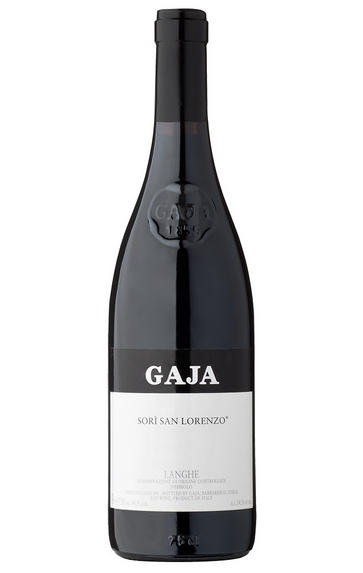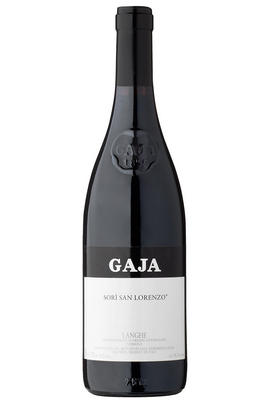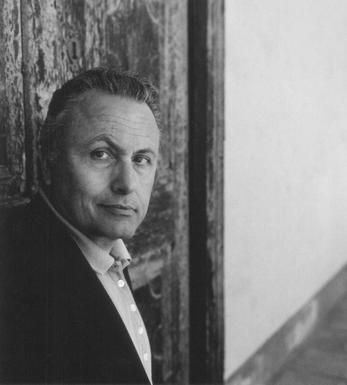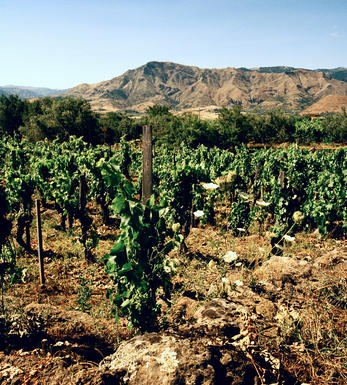
2014 Barbaresco, Sorì San Lorenzo, Gaja, Piedmont, Italy

Critics reviews
The 2014 Barbaresco Sorì San Lorenzo is the most virile and explosive of Gaja's Barbarescos. Dark, brooding and powerful, with a huge spine of tannin, the San Lorenzo is utterly regal in the glass. Gravel, smoke, menthol, tar, liquorice and a host of sepia-toned fruits build into a crescendo of aromas and flavours that is truly compelling. What a gorgeous wine this is.
The Gaja family's 2014 Barbarescos are more than worthy follow-ups to the stellar 2013s. The 2014s also show a bit more stylistic cohesion throughout the range than was the case with the 2013s. Overall, the 2014s are defined by their energy, tension and brilliant personalities. As good as Gaja's cru wines are, the straight Barbaresco - which is a blend of many top sites - is as good or nearly as good as those wines. It is also much more accessibly priced, even if none of these wines can be defined as inexpensive. Sadly, yields are down 35% across the board for the 2014s.
Drink 2026 - 2054
Antonio Galloni, Vinous.com (October 2017)
Gaja's 2014 Barbaresco Sor San Lorenzo is clearly at the beginning of a long and promising aging trajectory. At it's core, it shows a pinch of nervous energy and inner tightness that will surely unravel and soften as this beautiful wine continues along its magical journey in time. Angelo Gaja and his family present spectacular results in this controversial 2014 vintage. They have risen far above most of their peers and have shown a keen ability to understand their site and the versatility of their cherished Nebbiolo grape.
The variety sings with a loud and exuberant voice, first offering plenty of primary fruit like blackberry and dried cherry. It then follows up with savory earth and spice. This is a bright and youthful wine that is set steady for a long aging future.
Drink 2022 - 2045
Monica Larner, Wine Advocate (December 2017)
This is closed at first – indeed it's just a baby – but soon opens up with some air to display wild strawberries, red cherries, cedar and nutmeg. The palate is full but very tight and refined, showing firm, grippy tannins that need time, driven acidity and a long, minerally finish.
Better in 2020
James Suckling, JamesSuckling.com (October 2017)
Refined scents, with the wood playing a slightly more prominent role here than in the other wines, but with plenty of fruited aromatic upholstery to support it. On the palate, this is the only wine of the quartet where the red fruits begin to shade into black in this vintage – though they retain a chic briskness, with ample energy and lift. Spice, incense and refined, chiselled, palpable tannins complete the picture.
Andrew Jefford, Decanter.com
The 2014 Barbaresco Sori San Lorenzo is certainly one of the more structured, masculine 2014s. From more limestone soils and a slightly cooler, south-facing hillside, it offers a deeper ruby colour to go with beautiful notes of black cherries, currants, wood smoke, white flowers, and an undeniable minerality. Like all the 2014s, it’s incredibly elegant on the palate, with a Burgundian-like texture, fine tannin, and terrific length. As with the Sori Tildin, it unwinds with time in the glass, yet needs 4-5 years of bottle age and is going to cruise in the cellar for 20-25+ years.
Drink 2022 - 2047
Jeb Dunnuck, JebDunnuck.com (March 2018)
About this WINE

Gaja
Angelo Gaja is Italy`s most renowned and dynamic wine personality and his impact on wine production in the last 30 years cannot be overestimated.
Angelo Gaja took over the family business in 1970 and, as he says: *The challenge was to maintain the basic power and depth of Nebbiolo while polishing the wines to give them richer colour, fuller fruit, better balance and a more refined style.'
In pursuit of this aim Gaja replanted many of the vineyards, installed temperature-controlled, stainless steel tanks, introduced the concept of ageing wines in small oak barrels and began releasing single vineyard Barbarescos. Most controversial of all, Gaja planted some Cabernet Sauvignon and Chardonnay on prime Barbaresco land.
Today Gaja has 101 hectares of vineyards divided into 32 separate plots and produces around 30,000 cases of wine a year. Gaja produces world-class wines that sell for world-class prices; his latest venture is in Tuscany where he has acquired an estate in Montalcino.

Barbaresco
The Piedmontese DOCG zone of Barbaresco is responsible for producing some of Italy’s finest wines. It occupies the same region and uses the same grape (Nebbiolo) as its bigger brother Barolo, but is a third of the size (only 640 hectares versus Barolo’s 1,700 hectares). It is also 50 years younger than Barolo, having produced wine labelled Barbaresco since 1890.
Barbaresco earned its DOCG after Barolo in 1980, largely thanks to the efforts of Angelo Gaja. The soils are lighter here than in Barolo – both in colour and weight – and more calcareous. The slopes are also less favourably situated and (relatively speaking) yield earlier-maturing yet extremely elegant wines that require less oak ageing (normally one year in oak plus six months in bottle). The appellation’s key districts are Barbaresco, Treiso, Neive and Alba.
Recommended producers: Cigliuti, Gaja, Marchesi di Gresy

Nebbiolo
Nebbiolo is the grape behind the Barolo and Barbaresco wines and is hardly ever seen outside the confines of Piedmont. It takes its name from "nebbia" which is Italian for fog, a frequent phenomenon in the region.
A notoriously pernickety grape, it requires sheltered south-facing sites and performs best on the well-drained calcareous marls to the north and south of Alba in the DOCG zones of Barbaresco and Barolo.
Langhe Nebbiolo is effectively the ‘second wine’ of Piedmont’s great Barolo & Barbarescos. This DOC is the only way Langhe producers can declassify their Barolo or Barbaresco fruit or wines to make an early-drinking style. Unlike Nebbiolo d’Alba, Langhe Nebbiolo can be cut with 15% other red indigenous varieties, such as Barbera or Dolcetto.
Nebbiolo flowers early and ripens late, so a long hang time, producing high levels of sugar, acidity and tannins; the challenge being to harvest the fruit with these three elements ripe and in balance. The best Barolos and Barbarescos are perfumed with aromas of tar, rose, mint, chocolate, liquorice and truffles. They age brilliantly and the very best need ten years to show at their best.


Buying options
Add to wishlist
Description
The 2014 Barbaresco Sorì San Lorenzo is the most virile and explosive of Gaja's Barbarescos. Dark, brooding and powerful, with a huge spine of tannin, the San Lorenzo is utterly regal in the glass. Gravel, smoke, menthol, tar, liquorice and a host of sepia-toned fruits build into a crescendo of aromas and flavours that is truly compelling. What a gorgeous wine this is.
The Gaja family's 2014 Barbarescos are more than worthy follow-ups to the stellar 2013s. The 2014s also show a bit more stylistic cohesion throughout the range than was the case with the 2013s. Overall, the 2014s are defined by their energy, tension and brilliant personalities. As good as Gaja's cru wines are, the straight Barbaresco - which is a blend of many top sites - is as good or nearly as good as those wines. It is also much more accessibly priced, even if none of these wines can be defined as inexpensive. Sadly, yields are down 35% across the board for the 2014s.
Drink 2026 - 2054
Antonio Galloni, Vinous.com (October 2017)
wine at a glance
Delivery and quality guarantee